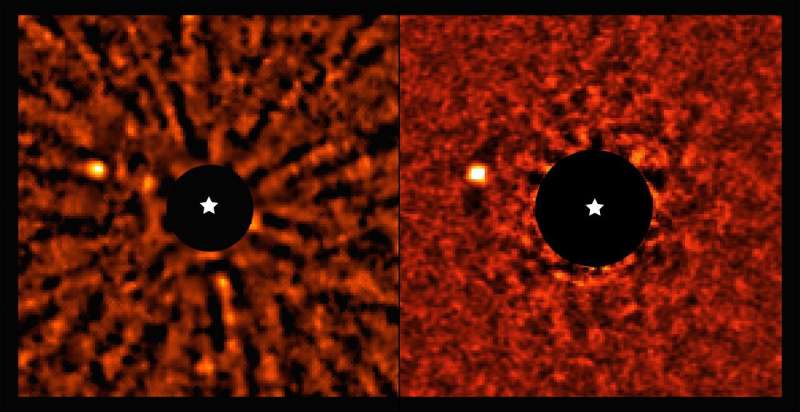This article has been reviewed according to Science X's editorial process and policies. Editors have highlighted the following attributes while ensuring the content's credibility:
fact-checked
trusted source
proofread
Spotting a hidden exoplanet

No, you're not seeing double: This photo shows two images of a Jupiter-like planet that orbits the star AF Leporis. The planet has been imaged by two independent groups of astronomers using the SPHERE instrument on ESO's Very Large Telescope (VLT) in Chile. But why did they target this particular star?
The two groups, led by Dino Mesa (INAF, Italy) and Robert De Rosa (ESO, Chile), studied star catalogs from the European Space Agency's Hipparcos and Gaia satellites. Over the years, these two space missions have accurately pinpointed the position and motion of stars in our galaxy using astrometry. Planets exert a gravitational tug on their host stars, perturbing their trajectory in the sky. The two teams found that the star AF Leporis exhibited such a disturbed trajectory, a telltale sign that a planet could be hiding there.
As the two groups took a closer look at this system with the VLT, they managed to directly image the planet that orbits AF Leporis. They both used the SPHERE instrument, which corrects the blurring caused by atmospheric turbulence using adaptive optics and also blocks the light from the star with a special mask, revealing the planet next to it. They found that the planet is just a few times more massive than Jupiter, making it the lightest exoplanet detected with the combined use of astrometric measurements and direct imaging.
The AF Leporis system shares similar features to our solar system. The star has roughly the same mass, size and temperature as the sun, and the planet orbits it at a distance similar to that between Saturn and the sun. The system also has a debris belt with similar characteristics as the Kuiper belt. Since the AF Leporis system is only 24 million years old—about 200 times younger than the sun—further studies of this system can shed light on how our own solar system was formed.
Scientific articles are accepted for publication in Astronomy & Astrophysics.
More information: D. Mesa et al, AF Lep b: the lowest mass planet detected coupling astrometric and direct imaging data, arXiv (2023). DOI: 10.48550/arxiv.2302.06213
Robert J. De Rosa et al, Direct imaging discovery of a super-Jovian around the young Sun-like star AF Leporis, arXiv (2023). DOI: 10.48550/arxiv.2302.06332
Provided by ESO

















